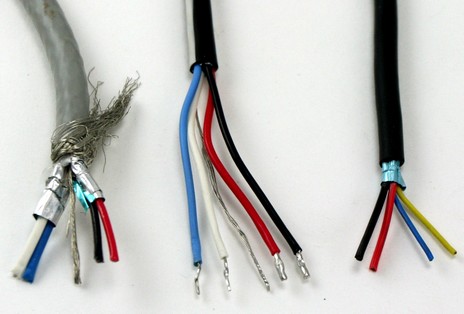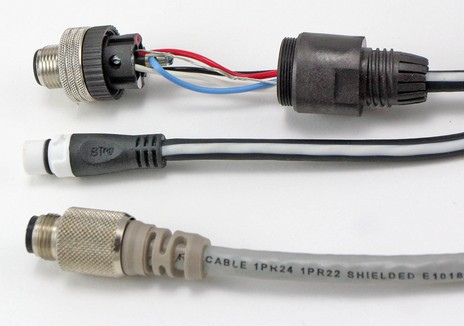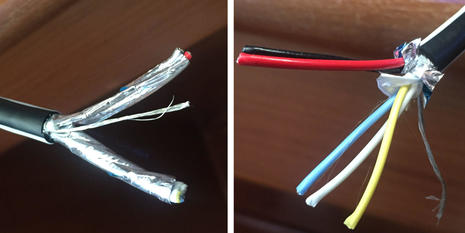N2K, cable mixing not a big woop

My macro photography needs improvement, as does my cable stripping, but I think this shot makes a point. From the left, the cables above are standard (DeviceNet) NMEA 2000, SeaTalkNG (aka NMEA 2000), and SimNet (aka NMEA 2000). Notice the similarities. The internal wires all adhere pretty closely to the NMEA color standard, which goes as follows, "Net" nomenclature included:
White: Net-H, "high" data signal
Blue: Net-L, "low" data signal
Bare: shield
Red: Net-S, 12v DC power supply
Black: Net-C, 12v DC ground
So the SimNet cable is slightly odd--the Net-H more yellow than white, and the shield apparently just foil, not wire--but then again it's the one that's truly skinny and light. I didn't have LowranceNet Red or Garmin "NMEA 2000" cables to strip, but I wouldn't be surprised if their wires were also color matched, and it doesn't matter much anyway because they are both plug compatible with standard N2K connectors and devices.
At any rate, the matching colors made it very easy for me to throw a Maretron micro-size field-attachable male connector (itself neatly color coded) onto the SeaTalkNG "stub" cable (below). Thus I was able to hang an ST70 display off the lab's ever-growing test N2K network. (And--bada bing--it powered up and slickly displayed about every data PGN available, but more on that later, this is about cables.) However, you don't have to make your own patch cable to marry SeaTalkNG (or SimNet) to standard NMEA 2000 cabling or devices. Raymarine later sent over both male and female adaptor cables and they're available for sale. In short, N2K cable mixing is not a big deal. Later I'll post more about the SeaTalkNG design, maybe even theorize about why it exists (short answer right now: no idea!). But before I close, let me draw your attention back to the standard cable above. Note the exterior braided shield plus the additional EMI shielding around each of the two wire pairs. If that cable costs about what the others do, and supports more installation doodads than any other system, why not use it?

PS 11/20/2016: The good Hartley Gardner sent photos of a Raymarine SeaTalkNG spur cable recently dissected. Note the separately shielded power and data wire pairs, the extra yellow wire for certain Seatalk1 uses, and the fact that the power wires are heavier gauge than standard N2K micro wires, which reduces voltage drop.


 Share
Share
Email notes from an interested engineer:
1. The Raymarine 'SeaTalkNG' cable is missing 1 or 2 points which we believe are important:
a. There really should be separate shielding foils around the two pairs (CAN Hi & Lo, and Power +/-) - so that the power noise cannot get on to the data pair.
b. The insulation on the CAN Hi & Lo (Blue and White) cables needs to be as thick as possible to help reduce the capacitance of the cable - so reducing the skewing of the signal. Not sure if this cable has less insulation on the blue and white cables (than the power wires), or its just the photo.
2. The SimNet cable is a worry - the lack of screen/drain wire will make connection of the shield very difficult for the user, and the thickness of the insulation on wires is very small - hence increasing the capacitance. If a large length of the bus was made using this wire, the 200 metres maximum bus length could be reduced considerably. If its purely for the drop cables (6 metres absolute max., 3 metres preferred max.), then I guess it may be acceptable.
3. The Maretron field attachable connector is a Woodhead / Brad Harrison connector (who were bought out by Molex last year...sad but true). Cheaper to buy direct.